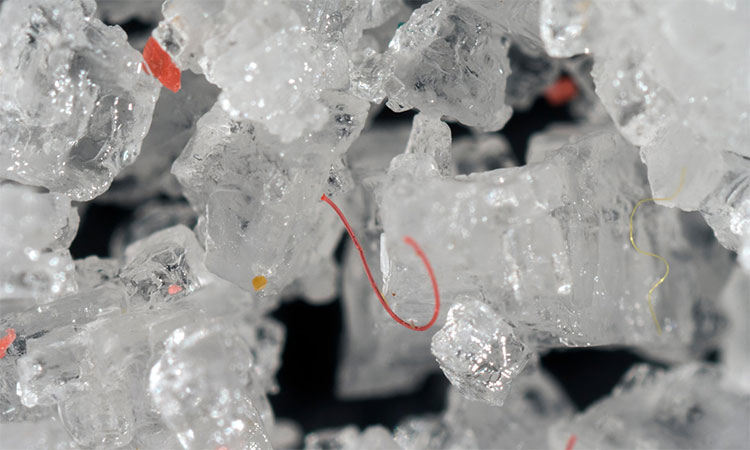Each person swallowed at least 50,000 micro-plastic beads every year
Each average person eats at least 50,000 micro-plastic particles a year and inhales a similar amount, according to a new study.
According to The Guardian (UK), this is the first study to estimate the amount of polluted plastic waste that humans have absorbed.
The real number may be much higher when only a small amount of food and water is taken into account. According to scientists, drinking bottled water seriously increases the amount of micro-plastic particles that humans consume.
It is unclear what the harmful effects of eating micro-plastic particles on humans are, but they may contain toxic substances. Some particles are so small that they can cause damage to tissues in the body, causing immune reactions such as cough, allergies .

Small pieces and plastic fibers found in crystalline salt crystals - (Photo: Paulo Oliveira / Alamy).
Pollution of plastic micro-particles is caused mainly by the breakdown of plastic waste and this situation is happening globally. Researchers found microparticles everywhere: in the air, soil, rivers and lakes and even the deepest seas in the world.
Micro plastic particles are also found in tap water, bottled water, seafood and beer. They were also found in human fecal samples for the first time in October last year - evidence that humans have eaten micro-plastic particles.
This study was published in the Journal of Environmental Science and Technology (USA), taking data from 26 previous studies that measured the amount of micro-particles in fish, shellfish, sugar, salt, beer and water, as well as air in big cities.
Scientists have used the diet regulated by the US Government to calculate the amount of micro-plastic particles that humans eat in a year.It is estimated that adults eat about 50,000 micro-plastic grains per year, while children are 40,000.
Most food and drinking water has not been tested, and the study only estimates 15% of the calories people consume.
"The number may be much larger. There is still a huge amount of data to be added," said Kieran Cox, head of research at Victoria University (Canada).
Other foods like bread, processed food, meat, dairy products and vegetables may also contain micro-plastic particles, said researcher Kieran Cox."There is a high chance that there will be a lot of micro-plastic particles in these foods. The number can be up to hundreds of thousands."
Bottled water has an average amount of micro plastic particles 22 times in tap water. A bottled water drinker will consume about 130,000 micro-particles per year from this source alone, compared to 4,000 seeds from tap water.
Scientists do not know what will happen when micro-plastic particles enter the human body, but this study has shown "most of them will be absorbed" than coughing and sneezing pushed out. The researchers also estimated that the micro-plastic content of a meal of the day could be up to 10,000 seeds / year.
Cox said the study completely changed his habits."I try not to use plastic packaging and avoid using bottled water as much as possible," he said.
"Removing disposable plastic products and supporting businesses that do not use plastic packaging will bring tremendous change ," Cox said.
- 90% of salt samples in the world contain micro-plastic
- Startled with the amount of plastic you are eating into your mouth every year
- Alarm micro plastic beads in beer
- Are we eating plastic waste daily?
- Startled with the amount of plastic you are eating into your mouth every year
- Corals reject shrimp eggs, choose to eat micro-plastic seeds
- Mosquitoes are the main cause of microbial contamination of animals?
- Detecting micro-plastic particles in rainwater, not only lies in the sea
- Detects micro plastic particles in a range of bottled water products
- First detected human body
- WWF: The Mediterranean is about to become
- What happens to a plastic bottle after being thrown into the trash?
- The danger when mosquitoes today carry plastic particles in the body
- Using a magnetic solution invented by NASA, the 18-year-old found a way to filter micro-plastic from water
 Is the magnetic North Pole shift dangerous to humanity?
Is the magnetic North Pole shift dangerous to humanity? Washington legalizes the recycling of human bodies into fertilizer
Washington legalizes the recycling of human bodies into fertilizer Lightning stone - the mysterious guest
Lightning stone - the mysterious guest Stunned by the mysterious sunset, strange appearance
Stunned by the mysterious sunset, strange appearance